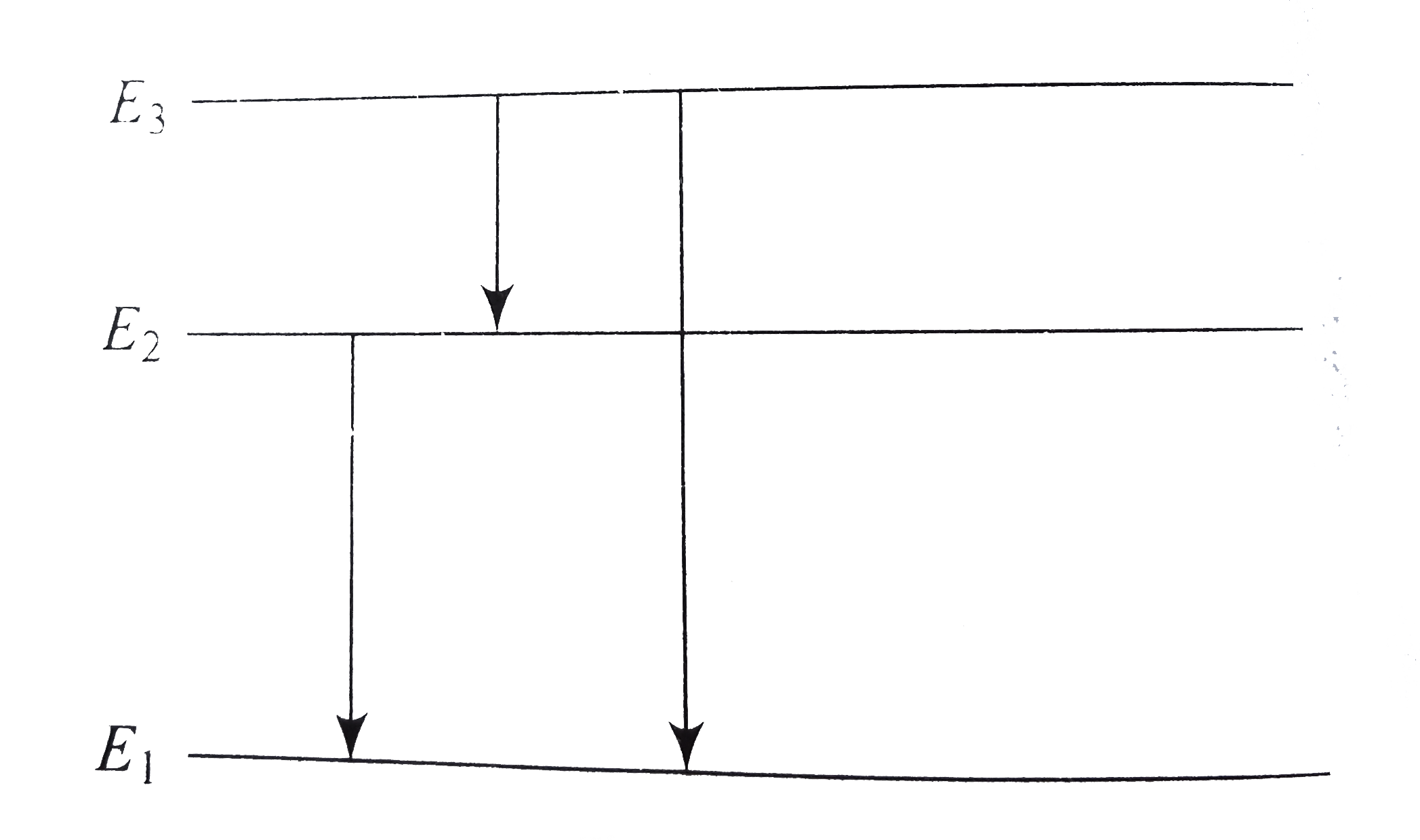A double ionized lithium atom is hydrogen like with atomic number 3
(i)Find the wavelength of the radiation to excite the electron in Li++from the first to the third bohr orbit (Ionization energy of the hydrogen atom equals 13.6eV
(ii) How many spectral lines are observed in the emission spectrum of the above excited system ?
The energy of the electron in nth orbit of hydrogen-like atom is
En=−Z2Rhcn2 Here , Z=3
and Rhc=13.6eV
a. The energy required to excite the electron in Li++ from (n=1) to (n=3) is
E3−E1=−Z2Rhc32−(−Z2Rhc12)
=Z2Rhc(1−19)
89=Z2Rhc=89×(3)2×13.6eV
=8×13.6eV=8×13.6×1.6×10−19J

Therefore , the wavelength of incidiation radition required for excitation is given by
hcλ=E3−E1
or λ=hcE3−E1=6.63×10−34×3×1088×13.6×1.6×10−19
=114.26×10−10m−114.26Å
b. The possible lines in the emission spectrum of this excited system are [nn−12=33−12=3]
Three in number , represented in figure.
Topper's Solved these Questions
- ATOMIC PHYSICSBOOK - CENGAGE PHYSICSCHAPTER - ATOMIC PHYSICSEXERCISE - Exercise 4.1
15 Videos
- ATOMIC PHYSICSBOOK - CENGAGE PHYSICSCHAPTER - ATOMIC PHYSICSEXERCISE - Exercise 4.2
12 Videos
- ATOMIC PHYSICSBOOK - CENGAGE PHYSICSCHAPTER - ATOMIC PHYSICSEXERCISE - ddp.4.3
15 Videos
- ALTERNATING CURRENTBOOK - CENGAGE PHYSICSCHAPTER - ALTERNATING CURRENTEXERCISE - QUESTION BANK
65 Videos
- ATOMSBOOK - CENGAGE PHYSICSCHAPTER - ATOMSEXERCISE - QUESTION BANK
40 Videos
Similar Questions
A double ionised lithium atom is hydrogen like with atomic number 3
(i)Find the wavelength of the radiation to excite the electron in Li++from the first to the third bohr orbit (lonisection energy of the hydrogen atom equals 13.6)
(ii) How many spectral lines are observed in the emission spetrum of the above excled system ?
View SolutionA doubly ionized lithium atom is hydrogen like with atomic number 3. Find the wavelength of the radiation required to excite the electron in Li++ from to the third Bohr orbit (ionization energy of the hydrogen atom equals 13.6 eV).
View Solution
Knowledge Check
A doubly ionized lithim atom is hydrogen like with atomic number 3. Find the wavelength of the radiation required to excite the electron in Li2+ from the first to the third Bohr orbit. The ionization energy of the hydrogen atom is 13.6 eV. (Take hc=1240 eV nm)
A11.4 nmB10.7 nmC12.7 nmD13.4 nmA double charged lithium atom is equivalent to hydrogen whose atomic number is 3. The wavelength of required radiation for emitted electron from first to third Bohr orbit in Li++ will be (Ionization energy of hydrogen atom is 13.6eV)
A18.51ÅB177.17ÅC142.25ÅD113.74Å(a) (i) Find the wavelength of the radiation required to excite thye elctron in Li(++) from the first to the third Bohr orbit.
(ii) How many spectal lines are observed in the emission spectrum of the above excited system ?
(b) The energy needed to detach the electron of a hydrogen-like ion in ground state in 4 rydberg.
(i) What is the wavelength of the radiation emitted when the electron jumps from the first excited state ot the ground state ?
(ii) What is the radius of first orbit ?
(c ) A hydrogen sample is prepared in a particular excited state A. Photons of energy 2.55 eV get absorbed into the sample to take some electrons to a further excited state B. Find the quantum number of the A and B.
(d) A hydrogen atom in a state having a binding energy of 0.85 eV makes transition to a state with excitation energy 10.2 eV. (i) Identify the quantum number n of the upper and the lower energy states.
Find λ.A108.8 e V ,3B13.6e V, 4C54.4 e V, 2D10.2 e V, 3
A doubly ionized lithium atom is hydrogen like with atomic
. number 3. Find the wavelength of the radiation to excite the electron in
. Li++ form the first to the third Bohr orbit. The ionization energy of the hydrogen
. Atom is 13.6V.
View SolutionConsider a gas consisting Li+2 (which is hydrogen like ion).
(a) Find the wavelength of radiation required to excite the electron in Li++ from n=1 and n=3. (Ionisation energy of the hydrogen atom equals 13.6eV).
(b) How many spectral lines are observed in the emission spectrum of the above excited system?
View Solution(a) (i) Find the wavelength of the radiation required to excite thye elctron in Li(++) from the first to the third Bohr orbit.
(ii) How many spectal lines are observed in the emission spectrum of the above excited system ?
(b) The energy needed to detach the electron of a hydrogen-like ion in ground state in 4 rydberg.
(i) What is the wavelength of the radiation emitted when the electron jumps from the first excited state ot the ground state ?
(ii) What is the radius of first orbit ?
(c ) A hydrogen sample is prepared in a particular excited state A. Photons of energy 2.55 eV get absorbed into the sample to take some electrons to a further excited state B. Find the quantum number of the A and B.
(d) A hydrogen atom in a state having a binding energy of 0.85 eV makes transition to a state with excitation energy 10.2 eV. (i) Identify the quantum number n of the upper and the lower energy states.
Find λ.
View SolutionA doubly ionized lithium atom is hydrogen like with atomic number 3. Find the electron in (Li++) from the first to thired Bohr orbit . The ionization energy of the hydrogen atom is 13.6eV.
View Solution(a)Find the wavelength of the radiation required to excited the electron is Li++ from the first to the third Bohr orbit (b) How many speciral are obseved in the emission apactrum of the above excited system?
View Solution
